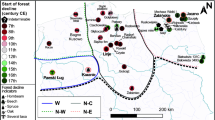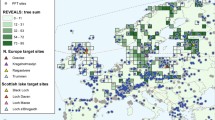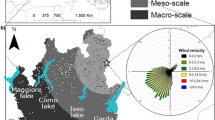Abstract
The resolution in time and space of palynologically reconstructed paleoecology has greatly improved. As a result, palynologists can now offer help to ecologists in the following areas:
-
A
Disturbance or Disappearance: Pollen records show that rain forests have been disturbed or destroyed by people for thousands of years. This is associated with soil erosion and in some cases with decline of civilizations.
-
B
Diversity and Stability: Palynology has refuted the idea that rain forests are unchanging through time, and provides a means of testing the refugium theory.
-
C
Population Dynamics: Pollen is a surrogate measure of population, therefore pollen records can be analysed as population records.
-
D
Causes of Altitudinal Zonation: Palynological evidence is consistent with control of zonation partly by UV-B insolation.
-
E
Seral Changes: Pollen records can be used to increase the time-coverage of eral changes.
Access this chapter
Tax calculation will be finalised at checkout
Purchases are for personal use only
Preview
Unable to display preview. Download preview PDF.
Similar content being viewed by others
References
Anderson JAL, Muller J (1975) Palynological study of a Holocene peat and a Miocene coal deposit from N W Borneo. Rev Palaeobotan Palynol 19: 291–351
Ashton PS (1969) Speciation among tropical forest trees: some deductions in the light of recent evidence. Biol J Linn Soc 1: 155–196
Bennett KD (1990) Models of plant population growth and analogies with reaction kinetics. Rev Palaeobotan Palynol 64: 247–251
Caldwell MM (1971) Solar UV irradiation and the growth and development of higher plants. In: Photophysiology, Vol.. VI, A C Giese, Vol. VI, pp 131–177, New York, Academic Press.
Clark RL (1983) Pollen and charcoal evidence for the effects of Aboriginal burning on the vegetation of Australia. Archaeol Oceania 18: 32–37
Deevey ES, Rice DS, Rice PM, Vaughan HH, Brenner S, Flanney MS (1979) Mayan urbanism: impact on a tropical karst environment. Science 206: 298–306
Flenley JR (1979) The equatorial rain forest: a geological history. London, Butterworths, 162 pp
Flenley JR (1985) Relevance of Quaternary palynology to geomorphology in the tropics and subtropics. In: Environmental Change and Tropical Geomorphology (I Douglas and T Spencer, eds.), pp 153–164, London, Allen & Unwin, 378 pp
Flenley JR, King SM (1984) Late Quaternary pollen records from Easter Island. Nature, Lond. 307: 47–50
Flenley JR, King ASM, Teller JT, Prentice ME, Jackson J, Chew C (in press). The Late Quaternary vegetational and climatic history of Easter Island. J Quat Sci
Geel B van, Hammen T Van der (1973) Upper Quaternary vegetational and climatic sequence of the Fuquene area (Eastern cordillera, Colombia). Palaeogeogr, Palaeoclimatol, Palaeoecol 14: 9–92
Gillett JB (1962) Pest pressure, an underestimated factor in volution. Taxonomy and Geography, Systematics Association Publication No. 4, pp 37–46
Goldammer JG, Seibert B (1989) Natural rain forest fires in Eastern Borneo during the Pleistocene and Holocene. Naturwissenschaften 76: 518–520
Golsen J, Hughes PJ (1976) The appearance of plant and animal domestication in New Guinea. I X Congress, Union International des Sciences, Prehistoriques et Protohistoriques, Nice, Proceedings
Green DG, Singh G, Polach H, Moss D, Banks J, Geissler EA (1988) A fine-resolution palaeoecology and palaeoclimatology from southeastern Australia. J Ecol 76: 790–806
Grubb PJ (1971) Interpretation of the ‘Massenerhebung’ effect on tropical mountains. Nature, Lond. 229: 44–45
Grubb PJ (1977) Control of forest growth and distribution on wet tropical mountains. Ann Rev Ecol Syst 8: 83–107.
Hammen van der T (1962) Palinologia de la Region de “Laguna de los Bobos”. Historia de su clima, vegetacion y agricultura durante los ultimos 5000 anos. Revta Acad Colomb Ciene exact fis nat Vol XI (44), pp 359–361 + 4
Hope GS, Petersen JA (1976) Palaeoenvironment. In: The Equatorial Glaciers of New Guinea (GS Hope, JA Peterson and U Radok, eds), Chapter 9, pp173–205 Rotterdam, A A Balkema, 244pp
Huntley B, Birks HJB (1983) An atlas of past and present pollen maps for Europe: 0–13000 years ago. 2 vols, 667 + maps, Cambridge, Cambridge Univ Press
Jacobson GL, Bradshaw RHW (1981) The selection of sites for paleovegetational studies. Quat Res 16: 80–96
Janzen DH (1970) Herbivores and the number of tree species in tropical forests. Am Nat 104: 501–528
King ASM, Flenley JR (1989) The Late Quaternary vegetational history of Easter Island. School of Geography and Earth Resources, University of Hull, Miscellaneous Series No. 31, 23 pp
Langford M, Taylor GE, Flenley JR (1986) The application of texture analysis for automated pollen identification, pp729–739 in Proc. Conference on Identification and Pattern Recognition; Toulouse, France, June 1986, Vol. 2. Pub. Univ. Paul Sabatier
Langford M, Taylor GE, Flenley JR (1990) Computerized identification of pollen grains by texture analysis. Rev Palaeobotan Palynol 64: 197–203
Livingstone DA (1982) Quaternary geography of Africa and the refuge theory. In: Biological diversification in the tropics. Proceedings of the Fifth International Symposium of the Association for Tropical Biology. (G T Prance, ed.),Chapter 28, pp 523–536, New York, Columbia University Press
Maloney BK (1981) A pollen diagram from Tao Sipinggon, a lake site in the Batak Highlands of North Sumatra, Indonesia. Mod Quatern Res in S E Asia 6: 57–66
Meggers BJ (1975) Application of the biological model of diversification to cultural distributions in tropical lowland South America. Biotropica 7: 141–161
Morley RJ (1981) Development and Vegetation Dynamics of a Lowland Ombrogenous Peat Swamp in Kalimantan Tengah, Indonesia. J Biogeogr 8: 383–404
Morley RJ (1982) A palaeoecological interpretation of a 10,000 year pollen record from Danau Padang, Central Sumatra, Indonesia. J Biogeogr 9: 151–190
Morrison MES, AC Hamilton (1974) Vegetation and climate in the uplands of south-western Uganda during the Later Pleistocene Period. II Forest clearance the other vegetational changes in the Rukiga Highlands during the past 8,000 years. J Ecol 62: 1–31
Muller J (1965) Palynological study of Holocene peat in Sarawak. Symposium on ecological research in humid tropics vegetation, pp 147–156.
Kuching, Sarawak, July, 1963. UNESCO Science Cooperation Office for Southeast Asia Muller J (1970) Palynological evidence on early differentiation of angiosperms. Biol Rev 45: 417–450
Muller P (1980) Biogeographie, Ulmer, Stuttgart, 414 pp 8
Murali NS, Teramura AH (1986) Intraspecific differences in Cucumis sativis sensitivity to ultraviolet-B radiation. Physiol. Plant 68: 673–677
Newsome J, Flenley JR (1988) Late Quaternary vegetational history of the Central Highlands of Sumatra. II Palaeopalynology & vegetational history. J Biogeogr 15: 555–578
Oldfield F (1970) Some aspects of scale and complexity in pollen-analytically based palaeoecology. Pollen et Spores 12: 163–71
Richards K (1987) A palynological study of the Late Quaternary vegetational history of Mboandong, a lowland lake in Cameroun. MSc Thesis, University of Hull, 160 pp
Ricklefs RE (1973) Ecology. London Nelson 861pp
Salgado-Labouriau ML (1980) A pollen diagram of the Pleistocene-Holocene Boundary of Lake Valencia, Venezuela. Rev Palaeobotan Palynol 30, 297–312
Salomons JB (1986) Paleoecology of Volcanic Soils in the Colombian Central Cordillera (Parque Nacional Natural de los Nevados). The Quaternary of Colombia 13: 1–212
Southern W (1986) The Late Quaternary environmental history of Fiji. PhD thesis, ANU, Canberra.
Steadman DW, Kirch PV (1990) Prehistoric extinction of birds on Mangaia, Cook Islands, Polynesia. Proc Natl Acad Sci, USA, 87: 9605–9609
Steenis CGGJ van (1971) Nothofagus, key genus of plant geography, in time and space, living and fossil, ecology and phylogeny. Blumea 19: 65–98
Sutton SL, Whitmore TC and Chadwick C (eds) (1983) Tropical rain forest: ecology and management. Blackwell Scientific Publications, Oxford
Tauber H (1965) Differential pollen dispersion and the interpretation of pollen diagrams. With a contribution to the interpretation of the elm fall. Danm Geol Unders II Series, No. 89: 1–69
Tauber H (1967) Investigations of the mode of pollen transfer in forested areas. Rev Palaeobotan Palynol 3: 277–286
Teramura H (1983) Effects of ultraviolet-B radiation on the growth and yield of crop plants. Physiol Plant 58: 415–427
Tsukada M (1967) Vegetation in subtropical Formosa during the Pleistocene glaciations and the Holocene. Palaeogeogr, Palaeoclimatol, Palaeoecol 3: 49–64
Walker D (1963) Stratigraphy and Ecology of a New Guinea Highlands Swamp. Proc Symposium on Ecological research in Humid Tropics Vegetation, Kuching, Sarawak. July 1963, pp 137–146
Walker D, Chen Y (1987) Palynological light on tropical rain forest dynamics. Quat Sci Revs 6: 77–92
Walker D, Flenley JR (1979) Late Quaternary vegetational history of the Enga District of upland Papua New Guinea. Phil Trans R Soc, 13, 286: 265–344
Walker D, Pittelkow Y (1981) Some applications of the independent treatment of taxa in pollen analysis. J Biogeogr 8: 37–51
Walker D, Wilson SR (1978) A statistical alternative to the zoning of pollen diagrams. J Biogeogr 5: 1–21
Webb LJ, Tracey JG, Haydock KP (1967) A factor toxic to seedlings of the same species associated with living roots of the non-gregarious subtropical rain forest tree Grevillea robusta. J appl Ecol 4: 13–25
Witte HHL (1988) Preliminary research into possibilities of automated pollen counting. Pollen Spores 30: 111–124
Author information
Authors and Affiliations
Editor information
Editors and Affiliations
Rights and permissions
Copyright information
© 1992 Birkhäuser Verlag Basel/Switzerland
About this chapter
Cite this chapter
Flenley, J.R. (1992). Palynogogical Evidence Relating to Disturbance and Other Ecological Phenomena of Rain Forests. In: Goldammer, J.G. (eds) Tropical Forests in Transition. Advances in Life Sciences. Birkhäuser Basel. https://doi.org/10.1007/978-3-0348-7256-0_2
Download citation
DOI: https://doi.org/10.1007/978-3-0348-7256-0_2
Publisher Name: Birkhäuser Basel
Print ISBN: 978-3-0348-7258-4
Online ISBN: 978-3-0348-7256-0
eBook Packages: Springer Book Archive




